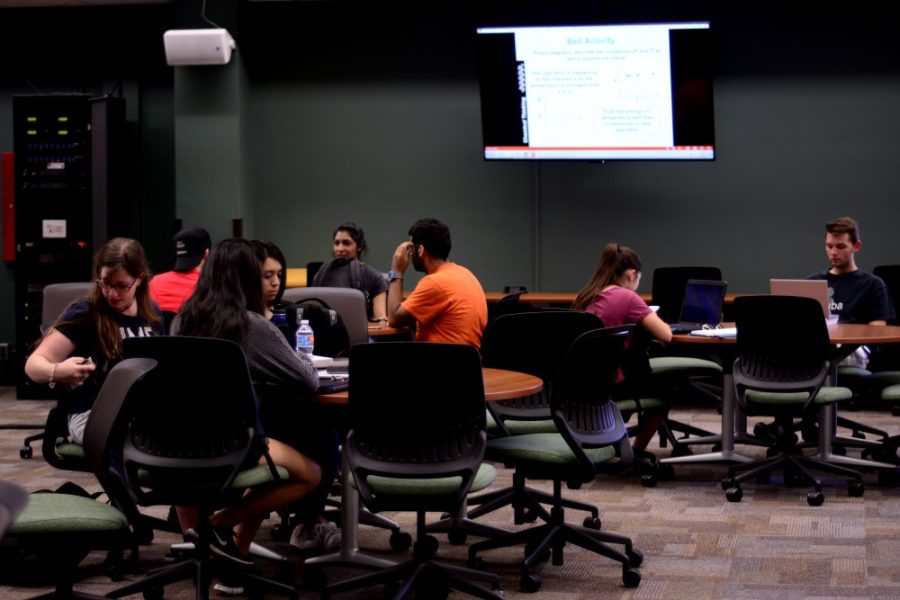John Pollard was quick to jump on the opportunity of expanding “active learning areas” at the UA by accepting the Association of American Universities’ new grant.
“Last fall, I was interested in possibly getting access to spaces around campus to have learning sessions where students could engage with each other more often,” said Pollard, a professor in the university’s general chemistry and biochemistry department.
He and eight other faculty members from other science, technology, engineering and mathematics fields were part of a pilot program to initiate the Collaborating Learning Spaces Project.
The CLS project stems from a $500,000 grant the UA was rewarded by the AAU in the summer of 2013. It was one of eight other universities throughout the nation to receive the grant funding.
The project’s main goal is to expand more effective, evidence-based methods for teaching students the core knowledge of foundational science and engineering courses.
“The main idea is to engage students to assimilate content and work their brains, as opposed to listening to me just talking,” said Paul Blowers, a distinguished professor in the department of chemical and environmental engineering at the UA.
Blowers said he has been working towards these active learning techniques since he began teaching at the UA in 1999. Instead of standing in front of a large auditorium with students packed in rows of seats, Blowers said he prefers larger spaces where students are broken into small groups to discuss the inner workings and concepts of the lesson.
“Students are pushed to focus on the process of learning, not just getting an answer,” Blowers said. “When the students ask, ‘is the answer 28.5?,’ we want to ask, ‘how did you get that?’ or ‘do you all agree on that answer?’”
The project was also the product of collaborative work between UA professors and administrators. Pollard said he sought help from administrators last fall to improvise new learning spaces for some classes exceeding 200 students.
“I first contacted the UA administrator, Gail Burd, and asked her if we could use some area in the [Student Union Memorial Center],” he said. “But she went a step better and ended up helping us reserve the [Science-Engineering Library] for it.”
Burd, the senior vice provost for academic affairs, said these efforts spanned from a frustration with active teaching.
“We pulled together this space, borrowed furniture, coordinated with the librarians,” Burd said, describing the initial frenzy and skepticism that came when first putting the plan into action. “Now we have 48 faculty members teaching courses and six spaces that we’ve revised, including rooms in the [Manuel T. Pacheco] Integrated Learning Center, Biosciences West [building], and the [Cesar E.] Chavez building.”
Burd, who is also a distinguished professor of molecular and cellular biology at the UA, stressed the use of evidence-based techniques in shifting the learning approach. She and other professors point out that throughout the entire U.S., major academic studies at hundreds of universities are concluding the increased benefits of active learning as opposed to the traditional lecture style of teaching.
One study was published in the Proceedings of the National Academy of Sciences journal, in which professors conducted a meta-analysis of 225 other studies that reported data from exams, assignments, failure rates and grades in STEM courses throughout the nation. One of its conclusions was “active learning [in these courses] leads to increases in examination performance that would raise average grades by a half a letter …”
While Burd acknowledges that there can be difficulties in changing from a traditional style to an active approach involving group work, she emphasizes the success and growth of the initial pilot program.
“It was tough at first for some students, but surveys and focus groups that we’ve done are now showing that they enjoy it more,” she said.
Other professors are also quick to espouse the benefits of this new teaching style. Blowers’ future hope is that an active-based learning approach, one with minimal lecturing, increased group work and an emphasis on processes over answers, will become the norm for most STEM classes.
“Anywhere you want more higher level thinking, these spaces are incredibly valuable for that,” he said.








